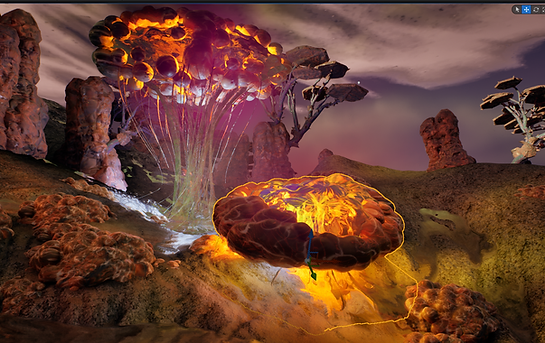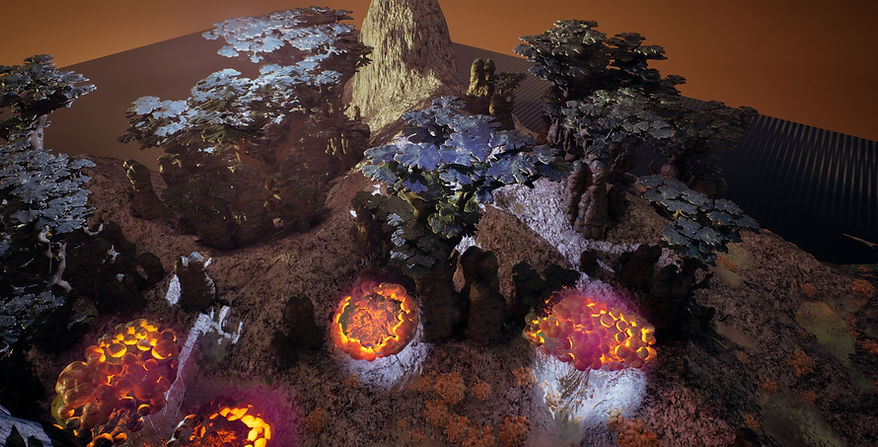
Planet Syrath
Planet Syrath
This is a procedural generation exercise set on an alien world.
Terrain assets were created using Houdini and integrated into Unreal Engine 5 with World Partition for large-scale environment management.
The planet features a unique ecosystem unlike Earth’s, with all vegetation procedurally generated—including spore-like lifeforms and rock-based structures resembling stone umbrellas.
Flowing water surfaces utilize flowmaps generated in Houdini, and the glowing movement of spores also leverages custom Houdini flowmaps for dynamic visual effects.
Planet Overview:
The planet's surface is red dust rich in oxidized iron, stretching like a blood-hued wasteland. Due to its thin atmosphere and high concentrations of toxic gases, such as sulfides, ammonia, and traces of acidic mist, it is inhospitable to traditional Earth-based life. Instead, a unique ecosystem has flourished under these extreme conditions.

Ecosystem: A World Dominated by Spore Flora
The surface is teeming with various forms of spore-based plant life:
-
Spore Trees: Massive, semi-transparent organic structures that resemble crystalline sculptures.
They store gel-like water inside large suspended sacs, resembling glowing jelly.
When water is abundant, the trees gently pulsate, releasing fine vapor and spores that nourish the surrounding spore colonies. -
Spore Moss: A red, fuzzy biofilm that carpets the ground, slowly absorbing trace amounts of moisture from the atmosphere.
-
Spore Vines: Spiraling growths that coil around Spore Trees. Their tips are covered in spore pods,
which burst when mature, releasing dense clouds of spores into the air.
These plants do not rely on traditional photosynthesis.
Instead, they absorb trace minerals, acid mists, and moisture directly from the toxic atmosphere.
This procedural spore-tree generator, built in Houdini, allows for customizable control over features such as aerial root length and density, the number of spores, overall plant height, canopy scale, and the twisting angle of the trunk.





The gel-like texture effect is created by baking a flowmap in Houdini and applying it within the material network in Unreal Engine.

According to the concept, this alien plant possesses fleshy spore structures and gelatinous aerial roots.
The material graphs:



The flow map is simply baked in Houdini flowmap node.
The moss movement is simulated in Houdini using a Copy to Points setup and MetaBall, with additional controls implemented through an Attribute VOP node.
Due to the fragility of the spore plants' gel-like structures, some larger plants have developed petrified features to shield against intense cosmic radiation.
The creation of the stone umbrellas (Stone Parasols) began with basic form generation in SpeedTree, followed by detailed canopy subdivision and geometric refinement in Houdini.



Water System: Gel Water Storage
Because liquid water cannot persist on the surface (due to rapid evaporation and low atmospheric pressure),
the "Gel Water" stored within Spore Trees has become the planet's most vital and precious form of hydration.
This gel is:
-
Semi-transparent and faintly bluish, with a subtle luminescence.
-
Highly viscous, allowing it to remain stable within the Spore Trees.
-
The core resource that sustains all life on the planet.



Landscape Workflow
I also developed a landscape scattering system in Houdini to procedurally distribute multiple types of vegetation and rock formations across the planet’s surface.



Atmospheric Conditions
-
Thin (low pressure)
-
Extremely low oxygen levels, mixed with high concentrations of toxic gases such as ammonia and hydrogen sulfide
-
The air is filled with microscopic spore particles, creating a faint red haze visible to the naked eye.
No organisms can breathe this atmosphere directly—not even native plant life,
which instead filters spores and acidic mists through specialized protective outer layers.
VDB Clouds
